 Research Article
Research Article
Reduction Ratio of Cattle Tick, Boophilus Annulatus Using Deltamethrin and Ivermectin In Taraman Farm, Sohag Governorate, Egypt
Desoky ASS1, SA Eraky2 and HEM Ahamed 1*
1Department of Plant Protection, Faculty of Agriculture, Sohag University, Egypt.
2Department of Plant Protection, Faculty of Agriculture, Assiut University, Egypt.
HEM Ahamed, Department of Plant Protection, Faculty of Agriculture, Sohag University, Egypt.
Received Date: November 07, 2020; Published Date: December 04, 2020/p>
Abstract
The present study was conducted to evaluate 2 acaricides, (Butox 5% EC spraying and Ivomec 1% injections) on cattle ticks in Taraman farm, Sohag Governorate, Egypt during 2019 year. The deltamethrinin (Butox 5%) spraying on hard ticks attached on the body of cows resulted in 64.44% reduction in the numbers of hard ticks, with a range for 58.33-71.43% during the months of the year. The results were similar when using ivermectin (Ivomec 1% L) injection, where the percentage of reduction in the numbers of ticks attached on cow body was 64.26%, and the percentage of reduction during the months of the year ranged from 53.66-75.00%.
Keywords: Acaricides; Butox; Deltamethrinin; Hard ticks; Ivomec; Ivermectin; Reduction.
Introduction
Ticks are among the most important ectoparasites of livestock in tropical and subtropical regions, and they are responsible for heavy economic losses, either through the direct effects of blood absorption or indirectly as vectors of pathogens and toxins. Feeding large numbers of ticks reduces livestock weight gain and anemia among pets, while tick bites also reduce leather quality. However, the large losses caused by ticks are due to the ability to transmit protozoa, rickettsia, and viral diseases to livestock, which have great economic importance worldwide [1,2].
The aim of this study is to evaluate deltamethrin (spray) and ivermectin (injection) against cattle ticks in animal production farms.
Materials and Methods
The control study of the hard tick infesting cows was performed in an animal farm of Taraman Island, Nag Abdullah. This farm is located on the road between Assiut and Sohag Governorates. The farm contains cows and buffaloes and scarce numbers of sheep and surrounded with few bushes. The predominant ectoparasite on the body of both cows and buffaloes was the hard tick. Ticks were counted on cow body before and after treatment (using Biotex 5% spraying on the body of cow and Ivermectin injection 1g / 50 kg for animal body weight).
Three of highly infested areas with hard ticks were selected and determined with distinctive signs, each was 10 cm², and this method was repeated twice monthly throughout a year for both pesticides used. The treatment of pesticides was done under the auspices of doctor, the veterinarian in charge of the farm. The reduction percentages on the numbers of hard tick, Boophilus annulatus infesting cows after treatment with two pesticides were monthly recorded.
Pesticides used
Data of pesticides used in the present study were summarized in Table 1.
Results and Discussion
Data in Table 2 and Figures 1 & 2 show the effect of spraying of deltamethrin (Butox 5%) on the numbers of hard ticks attached on cows’ body during the year months starting from January 2019. Results showed the effectiveness of deltamethrinin (Butox 5%) in reducing the numbers of hard tick attached on the body of cows by 64.44% with a range for 58.33-71.43%. The obtained results are in agreement with the finding of Mehlhorn who found that, the Deltamethrin containing product of Butox® protected sheep and cattle against midges, which suck blood at the legs or at the belly for at least 4 weeks, even if the animal becomes wet several times during these 4-5 weeks.
Table 1: Data of pesticides used in the present study were summarized.

Table 2: Monthly reduction (%) of hard ticks on cow bodies after spraying with deltamethrin (Butox 5%) in Taraman farm during the months of 2019 year.
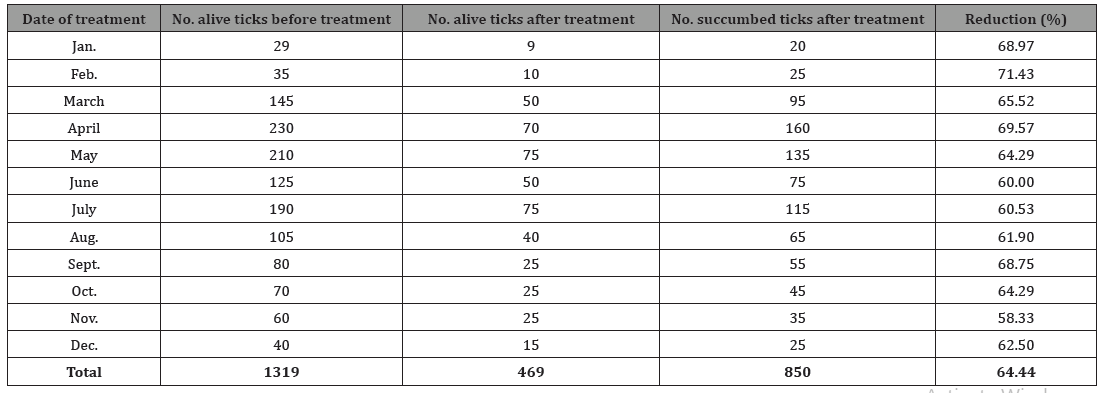
Table 3: reduction (%) of hard ticks on cow bodies after treatment with ivermectin (Ivomec 1% L) injections in Taraman farm during the months of 2019 year.
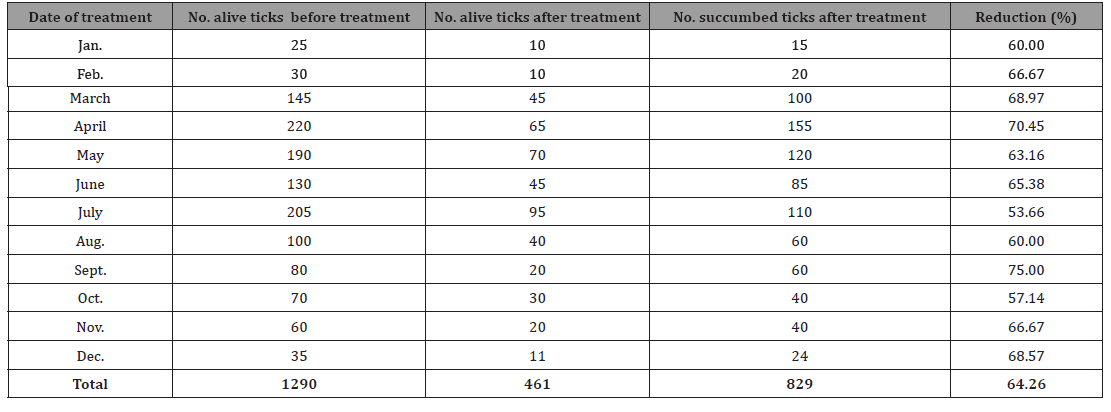
Table (2) Monthly reduction (%) of hard ticks on cow bodies after spraying with deltamethrin (Butox 5%) in Taraman farm during the months of 2019 year.
Figure (1) Number of alive hard ticks on cow bodies before and after spraying with deltamethrin (Butox 5%) in Taraman farm, during the year of 2019.
Figure (2) Monthly reduction (%) of hard ticks on cow bodies with deltamethrin (Butox 5%) spraying in Taraman farm, during the months of 2019 year.
Data in Table 3 and Figures 3 & 4 show the effect of ivermectin (Ivomec 1% L) injections on the numbers of hard ticks attached on cows’ body during the year months starting from January 2019. Results showed the effectiveness of ivermectin in reducing the numbers of hard tick attached on the body of cows by 64.26% with a range for 53.66-75.00%. These results similar with Ramzan evaluated the efficacy of Ivermectin, Doramectin and Azadirachta indica (neem- leaves) against tick infestation in cattle in Dera Ghazi Khan (Pakistan). They found that the efficacy of ivermectin, doramectin and neem against ectoparasites was 100%, 60% and 0%, respectively. [1] when used of ivermectin 1% injection (9 ml / 50 kg b.w.), resulted in decreasing the number of hard ticks on the body of animals by 69.53%. Roger found that, infestations with the cattle tick, Rhipicephalus (Boophilus) microplus, constitute the most important ectoparasite problem for cattle production in tropical and subtropical regions worldwide, resulting in major economic losses. The control of R. microplus is mostly based on the use of conventional acaricides and macrocyclic lactones. However, the intensive usage of such compounds has resulted in tick populations’ resistance to all major acaricide chemical classes. Consequently, there is a need for the development of alternative approaches, possibly including the use of animal husbandry practices, synergized pesticides, rotation of acaricides, pesticide mixture formulations, manual removal of ticks, selection for host resistance, nutritional management, release of sterile male hybrids, environmental management, plant species that are unfavourable to ticks, pasture management, plant extracts, essential oils and vaccination. Integrated tick management consists of the systematic combination of at least two control technologies aiming to reduce selection pressure in favour of acaricide-resistant individuals, while maintaining adequate levels of animal production.
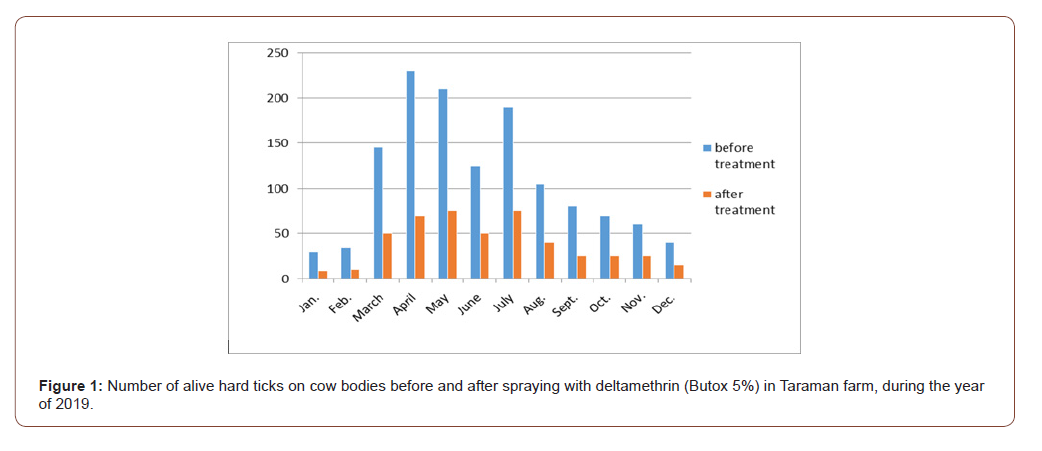
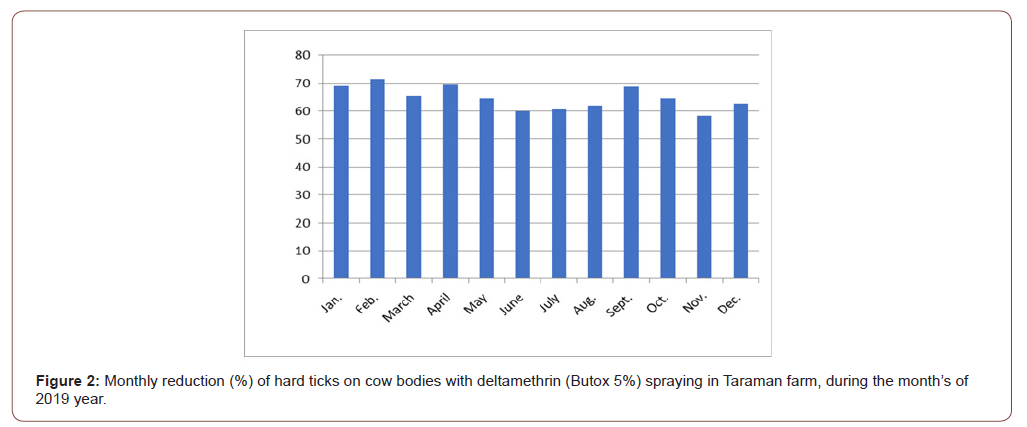

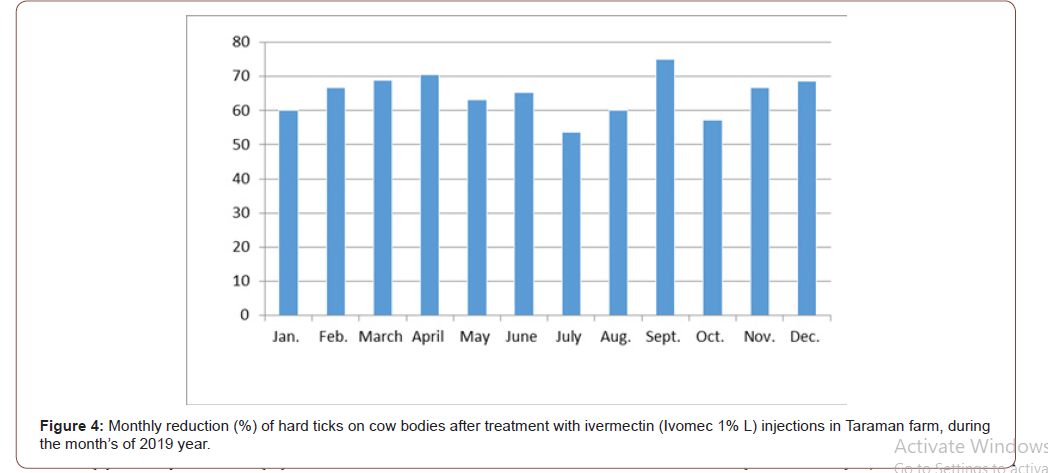
Figure (3) Number of alive hard ticks on cow bodies before and after treatment with ivermectin (Ivomec 1% L) injections in Taraman farm, during the year of 2019.
Figure (4) Monthly reduction (%) of hard ticks on cow bodies after treatment with ivermectin (Ivomec 1% L) injections in Taraman farm, during the month’s of 2019 year.
Generally, acaricides can only be used in high cases, but we can reduce the use of pesticides because of their harm to humans and animals through attention must be paid to the animal production farms in terms of cleanliness and ventilation, and the control of ticks, whether on body of animals or in places of laying eggs, because the adult stages of ticks leave their hosts to search for places to lay eggs (i.e., crevices, debris, under stones, branches of trees surrounding the farm). Hence, animal breeders must search for those places and control tick adult and immature stages away from their hosts, in addition to continues cleaning of the farm floor and removing debris and straw substrate are also recommended to eliminate immature stages of ticks.
Acknowledgements
None.
Conflict of interests
No conflict of interest to declare.
References
- Desoky ASS (2011) Studies on certain ectoparasites associated with some farm animals and their control, Ph.D. Thesis, Fac Agric Assiut Univ., Assiut, Egypt 52(249): 1727-1932.
- Nejash AA (2016) Review of Economically Important Cattle Tick and Its Control in Ethiopia.Vector Biology Journal 1(1).
- Mehlhorn H, V Walldorf, S Klimpel (2009) Bluetongue disease in Germany: monitoring of entomological aspects. Parasitol. Res 105: 321-329.
- Rajput ZI, S Hu, W Chen, AG Arijo, C Xiao (2006) Importance of ticks and their chemical and immunological control in livestock. J Zhejiang Univ Sci B 7(11): 912–921.
- Ramzan M, MS Khan, M Avais, JA Khan, K Pervez (2008) Prevalence of ectoparasites and comparative efficacy of different drugs against tick infestation in cattle. J. Anim. Pl. Sci 18(1): 17-19.
- Roger RV, NN Jonsson, C Bhushan (2017) Strategies for the control of Rhipicephalus microplus ticks in a world of conventional acaricide and macrocyclic lactone resistance. Parasitology Research volume 117: 3-29.
-
Desoky ASS, SA Eraky, HEM Ahamed. Reduction Ratio of Cattle Tick, Boophilus Annulatus Using Deltamethrin and Ivermectin In Taraman Farm, Sohag Governorate, Egypt. Arch Animal Husb & Dairy Sci. 2(3): 2020. AAHDS.MS.ID.000537.
-
Cost-Benefit; Nutrient digestibility; FCR; Serum Biochemistry.
-

This work is licensed under a Creative Commons Attribution-NonCommercial 4.0 International License.






